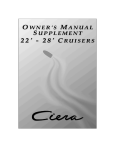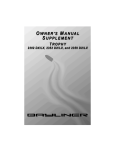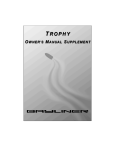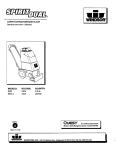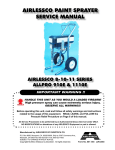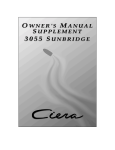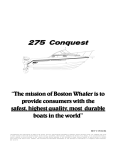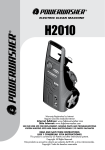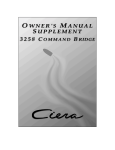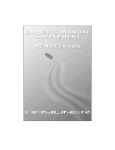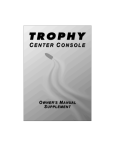Download Bayliner 1802FJ Owner`s manual
Transcript
The information in this Owner’s Manual Supplement relates to 1999 & 2000 Bayliner Trophy Fishing Boats. Hull Identification Number___________________________________________ Engine Serial Number _______________________________________________ Engine Serial Number _______________________________________________ Hull Identification Number: The Hull Identification Number (HIN) is located on the starboard side of the transom. Record the HIN and the engine serial number in the space provided above. Refer to the HIN for any correspondence or orders. STARBOARD HIN LOCATION (TYPICAL) TRANSOM © 2000 Bayliner Technical Publications. All rights reserved. No part of this publication may be reproduced, stored in any retrieval system, or transmitted in any form by any means, electronic, mechanical, photocopying, recording or otherwise, without prior written permission of Bayliner. Printed in the United States of America. General Notes The material in this document is for information only and is subject to change without notice. While reasonable efforts have been made in the preparation of this document to assure its accuracy, Bayliner assumes no liability resulting from errors or omissions in this document, or from the use of information contained herein. Due to our commitment to product improvement, Bayliner reserves the right to make changes in the product design, specifications, and equipment at any time without notice or obligation. Illustrations and/or photos may show optional equipment. All Bayliner products meet or exceed USCG and/or NMMA construction standarda. Manufactured with 1,1,1 Trichloroethane, a substance which harms public health and environment during the manufacturing process by destroying ozone in the upper atmosphere. Proprietary Rights This document discloses subject matter in which Bayliner has proprietary rights. The information and design disclosed herein were originated by and are the property of Bayliner. Neither receipt nor possession thereof confers or transfers any right to reproduce, copy, alter or disclose the document or any part thereof, any information contained therin, or to construct boats or any item from it, except by written permission from or written agreement with Bayliner. This document is to be returned upon request to Bayliner. Contents Chapter 1: Welcome Aboard! Chapter 3: General Systems 1 Hazard Warning Symbols 5 2 Dealer Service 2 Boating Experience 2 Engine/Accessories Guidelines 2 Safety Standards 3 Qualified Maintenance 3 Proprietary Rights 3 General Notes Electrical System 6 12-Volt DC System 7 Shore Power/110-Volt AC System 9 Navigation and Interior Lights 9 Bilge Blower 10 Fuel System 10 Fuel Fills and Vents 10 Fuel Filters 11 Bilge Pump 13 Fresh Water System Chapter 2: Product Descriptions 13 Water Heater 4 Specifications 13 Alcohol or Alcohol/Electric Stove (Option) 4 U.S. Coast Guard Maximum Capacities Label 14 110-Volt AC/12-Volt Refrigerator 14 Portable Toilet 14 Marine Head with Holding Tank 15 Bait Well System 15 Trim Tabs 16 Depth Finder 16 Anchoring 16 Compass 17 Canvas Top Installation: 17 Center Console 18 Cuddy Cabin Models Chapter 4: Drawings & Diagrams 19 1703 (FR) 20 1802 (FJ) 21 1903 (FK) 22 2002 (FF) 24 2052 (FD) Chapter 5: Wiring Diagrams 38 Shore Power 39 Single Engine (Outboard), Typical 40 Twin Engine (Outboard), Typical 41 Stern Drive, Typical 25 2352 (FV) Limited Warranty 27 2503 (FM) 42 What Is Not Covered 29 2509 (FW) 42 Other Limitations 33 2802 (FH) 42 Your Obligation 1 Chapter 1: Welcome Aboard! This Owner’s Manual Supplement was prepared to provide specific information about your boat. Read the Owner’s Manual and this supplement carefully, paying particular attention to the Limited Warranty section. Keep this supplement in a secure place and hand it over to the new owner when you sell the boat. Hazard Warning Symbols The hazard warning symbols shown below are used throughout this supplement to call attention to potentially dangerous situations which could lead to either personal injury or product damage. We urge you to read these warnings carefully and follow all safety recommendations. This symbol alerts you to immediate hazards which WILL cause severe personal injury or death if the warning is DANGER ignored. ! ! This symbol alerts you to hazards or unsafe practices which COULD result in severe personal injury or death if the warning is ignored. ! This symbol alerts you to hazards or unsafe practices which COULD result in minor personal injury, or cause product or property damage if the warning is ignored. ! This symbol calls attention to installation, operation, or maintenance information which is important to proper operation, but is not hazard-related. WARNING CAUTION NOTICE Fire and/or Rotating Propeller Personal Injury Hazard! Explosion Hazard! Hazard! Open Flame Hazard! Trophy Owner’s Manual Supplement 2 Chapter 1: Welcome Aboard! Dealer Service Make certain that you receive a full explanation of all systems from the selling dealer before taking delivery of your boat. Your selling dealer is your key to service. If you experience any problems with your new boat, immediately contact the selling dealer. If for any reason your selling dealer is unable to help, you can call us direct on our customer service hotline: 360-435-8957 or send us a FAX: 360-403-4235 Boating Experience If this is your first boat or if you are changing to a type of boat you are not familiar with, for your own comfort and safety, please ensure that you obtain handling and operating experience before assuming command of the boat. Your selling dealer, national sailing federation or yacht club will be pleased to advise you of local sea schools, or competent instructors. ! WARNING • A qualified operator must be in control of the boat at all times. • Do not operate your boat while under the influence of alcohol or drugs. Engine/Accessories Guidelines Your boat’s engine (or engines) and accessories were selected to provide optimum performance and utility. Installation of different engines or other accessories may cause undesirable handling characteristics. Should you choose to install different engines, or to add accessories that will affect the boat’s running trim, have an experienced marine technician perform a safety inspection and a handling test before operating your boat by yourself again. Safety Standards Your boat’s mechanical and electrical systems were designed to meet safety standards in effect at the time it was constructed. Some of these standards were mandated by law. All of them were designed to insure your safety, and the safety of other people, vessels and property. PERSONAL SAFETY HAZARD - Do not allow anyone to ride on parts of the boat that DANGER were not designated for such use: Sitting up on the seat backs, bow riding, gunwale riding, occupying the transom platform or the aft sundeck cushions while underway is especially hazardous and will cause personal injury or death. ! Trophy Owner’s Manual Supplement Chapter 1: Welcome Aboard! 3 Please read the Owner’s Manual, warning labels and all literature supplied with your boat for important safety standards and hazard information. Qualified Maintenance ! WARNING To maintain the integrity and safety of your boat, only qualified people should perform maintenance on, or in any way modify; the steering system, propulsion system, engine control system, fuel system, environmental control system, or electrical system. Failure to maintain these systems as designed could violate the laws in your jurisdiction, and could expose you and other people to the danger of bodily injury or accidental death. We recommend that you follow the instructions provided in this supplement, the Owner’s Manual, the engine owner’s manual, and the accessory instruction sheets included with your boat. Proprietary Rights This document discloses subject matter in which Bayliner has proprietary rights. The information and design disclosed herein were originated by and are the property of Bayliner. Neither receipt nor possession thereof confers or transfers any right to reproduce, copy, alter or disclose the document or any part thereof, any information contained therein, or to construct boats or any item from it, except by written permission from or written agreement with Bayliner. This document is to be returned upon request to Bayliner. General Notes The information contained herein is subject to change without notice and is not to be used in conjunction with sales or advertising, except as may be expressly permitted in writing by Bayliner. Actual operating results will vary depending on conditions and variables. All Bayliner products meet or exceed USCG and/or NMMA construction standards. Due to our commitment to product improvement, we reserve the right to change, without notice or other obligation, the specifications or other information contained in this publication. Manufactured with 1,1,1-Trichloroethane, a substance which harms public health and environment (during the manufacturing process) by destroying ozone in the upper atmosphere. Trophy Owner’s Manual Supplement 4 Chapter 2: Product Descriptions Overall Legnth Bridge Clearance Bridge Clearance With Hard Top or T-Top (Option) Beam Maximum Draft Fuel Tank Capacity (gal) ater Tank apacity (gal) Holding Tank Capacity (gal) Specifications 1703 (FR) Trophy Center Console 17’ 1” 4’ 11” N/A 6’ 11” 2’ 2” 27 N/A N/A 1802 (FJ) Trophy Cuddy 18’ 0” 5’ 2” N/A 7’ 6” 2’ 7” 40 N/A N/A 1903 (FK) Trophy Center Console 18’ 11” 5’ 8” 6’ 8” 7’ 8” 2’ 7” 55 N/A N/A 2002 (FF) Trophy Walkaround 20’ 1” 5’ 2” 7’ 10” 8’ 0” 2’ 7” 82 N/A N/A 2052 (FD) Trophy Walkaround 21’ 7” 5’ 6” 7’ 3” 8’ 0” 2’ 11” 64 N/A N/A 2352 (FV) Trophy Walkaround 25’ 5” 6’ 7” 8’ 1” 8’ 5” 2’ 10” 106 8 N/A 2503 (FM) Trophy Center Console 27’ 3” 6’ 2” 7’ 11” 8’ 5” 2’ 5” 105 N/A N/A 2509 (FW) Trophy Cuddy 27’ 3” 6’ 7” 8’ 1” 8’ 5” 2’ 5” 147 8 N/A 2802 (FH) Trophy Cuddy 31’ 0” 7’ 5” 9’ 6” 9’ 9” 2’ 6” 240 30 30 Model Description U.S. Coast Guard Maximum Capacities Label The U.S. Coast guard requires boats less than twenty (20) feet in length to have a Maximum Capacities Label stating the maximum horse power, the maximum number of persons and the maximum weight the boat will handle safely under normal conditions. The Maximum Capacities Label is typically located near the helm. Trophy Owner’s Manual Supplement 5 Chapter 3: General Systems Electrical System Read and understand the Electrical Section of the Owner’s Manual. ! DANGER EXTREME FIRE/EXPLOSION and ELECTRIC SHOCK HAZARD! • To minimize the risks of fire and explosion, NEVER install knife switches or other arcing devices in the fuel compartments. • NEVER substitute automotive parts for marine parts. Electrical, ignition and fuel system parts were designed and made to comply with rules and regulations that minimize risks of fire and explosion. • DO NOT modify the electrical systems or relevant drawings. • Fuel fumes are heavier than air and will collect in the bilge areas where they can be accidently ignited. Visually and by smell (sniff test), check the engine and fuel compartments for fumes or accumulation of fuel. Operate the bilge blower for at least four minutes prior to engine starting, electrical system maintenance or activation of electrical devices. • Only qualified personnel should install batteries and/or perform electrical system maintenance. • Insure that all battery switches are in the OFF position before performing any work in the engine spaces. • Minimize the danger of fire and explosion by not exposing batteries to open flame or sparks. It is also important that no one smoke anywhere near the batteries. ! CAUTION SHOCK and/or ELECTRICAL SYSTEM HAZARD! • NEVER disconnect the battery cables while the engine is running, as this can cause damage to your boat’s electrical system components. • The battery charging systems (alternator and, if applicable, battery charger) installed are designed to charge conventional leadacid batteries. Before installing gel-cell or other new technology batteries, consult with the battery manufacturer about charging system requirements. Trophy Owner’s Manual Supplement 6 Chapter 3: General Systems ! NOTICE ! NOTICE VOLTAGES - All boats use either 110-volt AC/60 Hertz, 240-volt AC/60 Hertz or 220-volt AC/50 Hertz single phase systems, and 12-volt DC or 24-volt DC. Electrical distribution panels are labeled with voltage and frequency of AC and DC. Electrical connections are prone to corrosion. To deter electrical problems due to corrosion, keep all electrical connections clean and protect them with a quality spray-on protectant such as Corrosion Guard®. 12-Volt DC System Fuses, Circuit Breakers and Switches TYPICAL ACCESSORY CIRCUIT MASTER BREAKER The engine is protected by a large circuit breaker on the engine. The accessories on some models are protected by a master circuit breaker usually located near the battery. In addition, a fuse block for branch accessory circuits is located behind the helm panel. Wires are color-coded to indicate which accessory each fuse services. Some items, such as radios and bilge pumps, may be fused individually at the unit. Autofloat switches are fused at the battery. Some models are equipped with battery switches. Your Owner’s Manual provides a general decription of battery switch function in the Batteries portion of the Electrical Section. The crossover switch should be turned on only in emergencies. Leaving the switch ON can drain all onboard batteries. CAUTION NEVER turn the battery switch(es) to the OFF position while the engine is running, as this can damage your boat’s electrical system. ! PORT (OR ONLY) BATTERY TYPICAL BATTERY SWITCHES Trophy Owner’s Manual Supplement STBD BATTERY Chapter 3: General Systems 7 Shore Power/110-Volt AC System Your boat may be equipped with a 110 volt AC system. AC systems are energized by dockside shore power. Standard dockside receptacles and cords provided are rated at 30 amps. Since some shore installations do not have 30 amp service, we recommend the purchase of 15 amp and 20 amp adapters. Note: When 15 amp or 20 amp adapters are used there will be a corresponding drop in supplied AC power. ! DANGER FIRE/EXPLOSION/SHOCK HAZARD! • To minimize shock and fire hazard, DO NOT modify electrical systems or relevant drawings. ONLY qualified personnel should install batteries and/or perform electrical system maintenance. DO NOT alter shore power connectors and only use compatible connectors. ! CAUTION SHOCK/ELECTRICAL SYSTEM DAMAGE HAZARD! • Never connect dockside power to your boat outside North America unless you have purchased the International electrical conversion option, which is rated for 220-volt/50 Hertz. North American systems are rated for 110-volt/60 Hertz power. • Use double insulated or three-wire protected electrical appliances when possible. WATER HEATER DAMAGE HAZARD! DO NOT energize the AC water heater electrical circuit until the heater is comCAUTION pletely filled with water. Even momentary operation in a dry tank will damage the heating elements. Warranty replacements will not be made on elements or tank damaged in this manner. The tank is full if water flows from the tap when the hot water is turned on in the galley. ! When using shore power, the simultaneous operation of several AC accessories can result in an overloaded circuit. It NOTICE may be necessary to turn off one accessory while operating another. ! Trophy Owner’s Manual Supplement 8 Chapter 3: General Systems ! WARNING FIRE/EXPLOSION/SHOCK/ ELECTRICAL SYSTEM DAMAGE HAZARD! • Before connecting to shore power, all breakers and switches on the AC master panel must be in the OFF position. Always attach the shore power cord to the boat inlet first, then to the dock connection, thereby avoiding accidental submersion of the “HOT” cord into the water. To disconnect, first remove the dock connection before removing the cord from the boat. • Monitor the electrical control panel’s polarity indicators when connecting shore power to your boat. A GREEN light illuminating after the power cord is plugged into the boat’s external power receptacle indicates acceptable electrical power in which you may energize the main breaker switches. A RED light, however, indicates reversed polarity, which could cause electrical system damage and possibly electrical shock injuries. In this case, DO NOT energize the main breaker switches. Instead, immediately disconnect the shore power cord (always from the dockside outlet first) and notify marina management. Check for proper polarity as outlined in the warning above. Activate the AC system by first turning on the master breaker, then each individual component breaker as required. SHORE POWER LOCATION ON 2802 (FH) DOCKSIDE PANEL LOCATION ON 2802 (FH) AFT AFT GALLEY VIEW Trophy Owner’s Manual Supplement Chapter 3: General Systems 9 Navigation and Interior Lights We strongly recommend that you understand navigation light usage as outlined in the Navigation section of the Owner’s Manual. The navigation and interior lights supplied with your boat are of top quality, but may periodically fail for a variety of reasons: 1. 2. 3. 4. There may be a blown fuse (Replace the fuse in the switch panel). The bulb may be burned out (Carry spare bulbs for replacement). The bulb base may be corroded (Clean the base periodically and coat it with non-conductive grease). A wire may have come loose or may be damaged (Repair as required). ! CAUTION • Avoid the storage of gear where it would block navigation lights from view. • Prolonged operation of cabin interior lights (overnight) will result in a drained battery. Be conservative in the use of battery power. Bilge Blower The bilge blower removes fumes from the engine compartment and draws fresh air into the compartment through the deck vents. TYPICAL BLOWER SYSTEM To ensure fresh air circulation, operate the bilge blower for at least four minutes before starting the engine, during starting, and while operating the boat below cruising speed. Operation of the blower system is NOT A GUARANTEE that explosive fumes have been removed. WARNING If you smell any fuel, DO NOT start the engine. If the engine is already running, immediately shut off the engine and all electrical accessories. Investigate immediately. DO NOT obstruct or modify the ventilation system. ! Trophy Owner’s Manual Supplement 10 Chapter 3: General Systems Fuel System Fuel Fills and Vents Fuel fills are located either on the aft deck or on the side decks adjacent to the aft cockpit. Fuel receptacle caps are marked “GAS”. Fuel vents are normally located in the hull or transom below and in the same general area as the fill. If you experience difficulty filling the fuel tank, check to see that the fuel fill and vent lines are free of obstructions and kinks. Fuel Filters Fuel filters should be replaced periodically to ensure that they remain clean and free of debris. A fine mesh screen filter is located on the fuel pickup tube. An additional filter, when supplied by the engine manufacturer, is installed on the engine. Consult your selling dealer or local marina concerning fuel additives that help to prevent fungus or buildup in your fuel tanks. TYPICAL FUEL SYSTEM FUEL TANK DECK FITTING, FUEL FILL FUEL TANK VENT FUEL FEED HOSE ! WARNING ! FIRE/EXPLOSION HAZARD - It is very important that the fuel system be inspected thoroughly the first time it is filled and then at each subsequent filling. For your safety and the safety of your passengers, the fueling instructions in the Owner’s Manual must be followed. Avoid the storage or handling of gear near the fuel lines, fittings and tank. CAUTION Trophy Owner’s Manual Supplement Chapter 3: General Systems 11 Bilge Pump Your boat is equipped with one or more impeller-type bilge pumps. They are controlled by a switch on the dash panel, which should be activated whenever water begins to accumulate in the bilge. Some models will also have an automatic bilge pump switch (“autofloat switch”) mounted next to the bilge pump. This is a float-type switch that will activate a bilge pump automatically whenever the bilge water accumulates above a pre-set level. It is wired directly to the battery so it will normally function even when the boat is completely shut down and unattended, such as when the boat is moored at a marina. TYPICAL BILGE PUMP SYSTEM TRANSOM FLOAT SWITCH BILGE PUMP HOSE THRU-HULL Maintenance Operation of the bilge pump should be checked often. To check the bilge pump, activate the dash-mounted switch and verify that water in the bilge is pumped overboard. If bilge water is present and the pump motor is running but not pumping, inspect the discharge hose for a kink or collapsed area. If no problems are found, check the bilge pump housing for clogging debris: To remove the power cartridge: 1. 2. TAB FIN Lift the tab while rotating the fins counter clockwise and lift out the power cartridge (Fig. 1). Clear the housing of debris. To reinstall the power cartridge: 1. Make sure the “O” ring is properly located and coat the “O” ring with a light film of vegetable oil or mineral oil (Fig. 2). FIG. 1 Trophy Owner’s Manual Supplement 12 Chapter 3: General Systems 2. Align the two cams on either side of the power cartridge with the two slots on the outer housing. Press the power cartridge into the housing and twist clockwise. Ensure proper reinstallation by attempting to twist the fins counter clockwise without lifting the tab. The cartridge should stay in place. If applicable, the autofloat switch should also be checked often for proper operation. Lift the float by turning the plastic insert, where the wires enter the housing, 1/4 turn counter clockwise (Fig. 3). LIGHT FILM “O” RING OF OIL POWER CARTRIDGE FIG. 2 As the float is lifted, the bilge pump should turn on. If lifting the float does not turn the pump on, check the inline fuse. If the fuse is good but the switch does not work, it may indicate a bad switch or possibly a low battery. TYPICAL FLOAT SWITCH FLOAT DETAIL FIG. 3 FLOAT PLASTIC INSERT ON POSITION (UP) OFF POSITION (DOWN) ! NOTICE Discharge of oil, oil waste or fuel into navigable waters is prohibited by law. Violators are subject to legal action by the local authorities. Trophy Owner’s Manual Supplement Chapter 3: General Systems 13 Fresh Water System Your boat features a pressure-type (demand) fresh water system. This system operates when the pump switch, located near in the galley, is turned ON. Turn the pump switch OFF when the boat is not in use and when the water tank is empty. Stored water can become stagnant and distasteful. Pump the water tank dry before leaving your boat unattended for long periods of time. Occasionally you may want to disinfect your water system. Ask your selling dealer about available treatments and procedures. Your boat may be equipped with a shower. Please read and follow the manufacturer’s operating instructions supplied in your baot’s owner’s packet. Water Heater Your boat may feature a water heater. Please refer to the owner’s packet for manufacturer’s operating instructions. The water heater is connected to the AC power system. If your boat is equipped with optional freshwater engine cooling, the coolant from the closed engine cooling system may be circulated through the hot water tank for heating of potable water. WATER HEATER DAMAGE HAZARD! DO NOT energize the AC water heater electrical circuit until the heater is CAUTION completely filled with water. Even momentary operation in a dry tank will damage the heating elements. Warranty replacements will not be made on elements or tank damaged in this manner. The tank is full if water flows from the tap when the hot water is turned on in the galley. ! Alcohol or Alcohol/Electric Stove (Option) Your boat may feature an alcohol or alcohol/electric stove. Manufacturer’s operating instructions can be found in the boat’s owner’s packet. Carefully read the operating instructions before using the stove. ! Reduce the possibility of fire by removing all combustible materials away from the stove before/during use. WARNING Trophy Owner’s Manual Supplement 14 Chapter 3: General Systems 110-Volt AC/12-Volt Refrigerator Your boat may feature a 110-volt AC/12-volt DC refrigerator. Please refer to the manufacturer’s instructions supplied in your boat’s owner’s packet. The refrigerator operates on 12-volt DC power unless the 110-volt AC system is hooked up to shore power and the AC refrigerator breaker is ON. In less than 24 hours, the refrigerator can render a 100-amp battery useless for engine starting. When operating on 12-volts, it is advised that the cold setting not be set higher than two (2). NOTICE It is also advisable to turn off your refrigerator at night or when not in use. If you are going out for more than a day and cannot connect to dockside power, plan to run the engine each day to maintain a charged battery. ! Portable Toilet If your boat features a portable toilet, carefully read and follow the manufacturer’s operating instructions supplied in your owner’s packet. Marine Head with Holding Tank Your boat may come equipped with with a marine head and holding tank. Be sure to follow the manufacturer’s operating instructions included in the boat’s owner’s packet. Seawater is used to flush waste from the toilet into the holding tank. The holding tank is plumbed to a waste fitting on the deck for use at a dockside pump-out station, and to a macerator pump so that waste may be pumped overboard (where regulations permit). The switch for the macerator is usually located at the helm station. If at any time you are unable to pump water into the bowl, the probable cause is debris in the pump diaphragm. To remedy this, shut the inlet seacock and dismantle the pump. The pump is generally held together with six screws. The design is simple and the problem will be obvious when the pump body is split open. To winterize the toilet, shut off the intake valve and pump until the bowl is dry. Remove the drain plug in the base and pump again to remove all water. Do not fill the bowl with antifreeze. The inlet seacock should be left closed while the boat is underway, or whenever the boat is left moored in the water. Trophy Owner’s Manual Supplement Chapter 3: General Systems 15 Bait Well System Your boat may feature a bait well. A typical bait well system begins with the (1) hi-speed pickup located on the underside of the hull. A (2) seacock valve is attached to the pickup. The seacock allows for immediate shutdown if needed. A water hose leads from the seacock to the (3) water pump. This pump is normally located in the bilge area or possibly higher in a storage area. The water continues from the pump to the aerator valve and into the bait well. Typically bait wells have an overflow stand pipe and a full drain system. The bait well switch is on or near the main dash panel. The water pump will pump a constant flow of water into the bait well when the seacock is open and the switch is on. 1 2 3 TO AERATOR VALVE TYPICAL BAIT WELL PICKUP SYSTEM BAIT WELL STAND PIPE DRAIN AERATOR VALVE REMOVE STAND PIPE TO COMPLETELY DRAIN BAIT WELL TYPICAL BAIT WELL DRAIN SYSTEM Trim Tabs Your boat may come equipped with trim tabs, which control the longitudinal and lateral trim of your boat at cruising speeds. Two rocker switches identified by the words “BOW DOWN” are located at the helm station. Once the best bow cruising trim is achieved, activate the port or starboard trim switches individually to correct for unequal lateral loading. DO NOT use the trim tabs to compensate for excessive unequal weight distribution. Trim tab adjustment should be performed by several short touches to the trim button rather than one long one. Allow approximately five seconds for the hull to react between each switch activations. The trim tab hydraulic fluid reservoir is located in the engine compartment. The fluid level should be checked periodically (at least once a year) and refilled as necessary. ! WARNING Improper use of trim tabs may cause loss of control. DO NOT use trim tabs in a following sea as they may cause broaching or other unsafe handling characteristics. DO NOT let anyone unfamiliar with trim tabs to operate them. Trophy Owner’s Manual Supplement 16 Chapter 3: General Systems Depth Finder Your boat may come equipped with a depth finder. The depth finder comes with its own owner’s manual. We suggest that you read it carefully before using the unit. DO NOT use the depth finder as a navigational aid to prevent collision, grounding, boat damage or personal injury. When the WARNING boat is moving, submerged objects will not be seen until they are already under the boat. Bottom depths may change too quickly to allow time for the boat operator to react. If you suspect shallow water or submerged objects, operate the boat at very slow speeds. ! Trophy models not equipped with depth finders may have a tube laminated into the hull for installing a depth finder transducer. The tube goes though bulkheads which serve as fuel vapor barriers, so both ends of the tube have been sealed. To install a transducer, pull the sealed ends off the tube and use the string inside to pull the tranducer cable through. After pulling the cable through, you MUST reseal both ends of the tube to ensure it is vapor-tight. ! WARNING Failure to reseal the transducer routing tube after removing the factory installed seals can cause fire, explosion and possible injury or death. Anchoring We strongly recommend that you read and understand the Anchoring section of the Owner’s Manual. ! WARNING FLOODING AND SWAMPING HAZARD - Never anchor by the stern alone--there is less freeboard and flooding or swamping is more likely to occur. When using only one anchor, secure the anchor line to the bow cleat or bow eye. Compass Your boat may come equipped with a compass. Carefully read and follow the manufacturer’s calibration and operating instructions provided in the owner’s packet. Trophy Owner’s Manual Supplement Chapter 3: General Systems 17 Canvas Top Installation: Center Console 1. 2. 3. 4. 5. 6. Attach end eyes of main bow (A) to aft deck hinges (B) and secure with pin. Push bimini to upright position and connect black plastic clip on end of hold-down strap (C) to chrome eye straps (D) to temporarily hold bimini top in place. Attach fwd brace (E) to fwd deck hinge (F) and secure with pin. Attach side brace (G) to the quick release jaw slide on secondary bow (H) and secure with pin. Adjust jaw slides, if needed, to obtain a tight bimini top. Tighten set screws to hold bimini in place. Tighten hold down straps (B) at forward end of bimini top. Trophy Owner’s Manual Supplement 18 Chapter 3: General Systems Cuddy Cabin Models J H I A D E C B F G 1. 2. 3. 4. 5. 6. Attach end eyes of main bow (A) to aft deck hinges (B) and secure with pin. Attach fwd brace (C) to secondary bow (D). Insert end eye of aft brace into aft bow hinge (E) and secure with pin. Attach aft brace (F) to main bow (A). Insert end eye of aft brace into aft bow and hinge (G) and secure with pin. Make canvas taut by pulling aft and down on aft side of bimini top while securing aft brace jaw slide (H). Also pull forward and down on the fwd side of the bimini top while securing fwd brace jaw slide (I). Tighten top straps (J), if needed, by adjusting the buckle slide. If additional canvas (i.e. side curtains, slant back cover or camper cover) is to be installed, it should be secured to the top canvas before final adjustment. Like the top, the additional canvas should be smooth and taut. Trophy Owner’s Manual Supplement 19 Chapter 4: Drawings & Diagrams 1703 (FR) Layout View Hull Exterior View BILGE PUMP DRAIN STARBOARD HULLSIDE BOW EYE TRANSOM STERN EYES SCUPPER, TYP. PORT & STBD GARBOARD DRAIN Hull Wire Routing BATTERY CONSOLE STERN LIGHT Trophy Owner’s Manual Supplement 20 Chapter 4: Drawings & Diagrams 1802 (FJ) Layout View Hull Exterior Hardware BLGE PUMP DRAIN FISH LOCKER DRAIN STBD HULLSIDE BOW EYE TRANSOM STERN EYE (TYPICAL PORT/STBD) GARBARD DRAIN Electrical Harness DOME LIGHT STERN LIGHT SUMP Trophy Owner’s Manual Supplement WIPER (OPTION) BOW LIGHT Chapter 4: Drawings & Diagrams 21 1903 (FK) Layout View Hull Exterior Hardware AFT BILGE PUMP DRAIN BAIT WELL DRAIN BOW STORAGE DRAIN STBD HULLSIDE BOW EYE AFT DECK DRAINS (TYPICAL PORT/STBD) TRANSOM GARBOARD DRAIN STERN EYE (TYPICAL PORT/STBD) Wire Harness Routing BOW LIGHT DECK HARNESS CONSOLE COURTESY LIGHTS SUMP PUMP AERATOR SEACOCK GROUND PUMP FUEL TANK SENDER CONSOLE BATTERY STERN LIGHT ENGINE GARBOARD DRAIN GROUND HULL HARNESS BILGE PUMP Trophy Owner’s Manual Supplement 22 Chapter 4: Drawings & Diagrams 2002 (FF) Layout View step Hull Exterior Hardware FISHWELL DRAIN, TYP. PORT & STBD. BILGE DRAIN FUEL TANK VENT BAIT WELL DRAIN STARBOARD HULLSIDE DECK DRAINS (TYPICAL PORT/STBD) TRANSOM STERN EYE (TYPICAL PORT/STBD) Trophy Owner’s Manual Supplement GARBOARD DRAIN TRIM TAB (TYPICAL PORT/STBD) Chapter 4: Drawings & Diagrams 23 Deck & Bilge Harness STERN LIGHT COURTESY SPEAKER LIGHT SHIFTER FUEL FISH WELL KILL GROUND PUMP SWITCH DASH PLUG WIPER COMPASS HORN BILGE PLUG STERN LIGHT ENGINE PLUG BOW LIGHTS ACCY BREAKER FISH WELL PUMP INTERIOR LIGHT STEREO SPEAKER WIPER ANTENNA WIRE COURTESY LIGHT BILGE HARNESS PLUG TO BILGE PUMP & FLOAT SWITCH TO BAIT WELL PUMP TO FUEL SENDER Head Pump-out (Option) PORTA-POTTY VENT PORTA-POTTY Trophy Owner’s Manual Supplement 24 Chapter 4: Drawings & Diagrams 2052 (FD) Layout View rod holder step Hull Exterior Hardware BAIT WELL DRAIN FUEL VENT BILGE DRAIN FISHWELL DRAIN, TYP. PORT & STBD DECK DRAINS (TYPICAL PORT/STBD) TRANSOM STARBOARD HULLSIDE GARBOARD DRAIN STERN EYE (TYPICAL PORT/STBD) TRIM TAB (OPTION) (TYPICAL PORT/STBD) Electrical Harness Routings ENGINE PLUG BILGE PLUG STBD. FISHWELL PUMP TRIM PUMP BAIT WELL PUMP STBD. COURTESY LIGHT PORT FISHWELL PUMP BLOWER FUEL GROUND STERN LIGHT STBD. SPEAKER BUSS BAR SHIFTER KILL SWITCH PORT COURTESY LIGHT DASH PLUG BILGE HARNESS PLUG TRANSOM STBD. WIPER PORT SPEAKER STEREO ANTENNA WIRE COMPASS LIGHT INTERIOR LIGHT HORN PORT WIPER PORT BOW LIGHT Trophy Owner’s Manual Supplement STBD. BOW LIGHT BILGE PUMP & FLOAT SWITCH TO FUEL SENDER Chapter 4: Drawings & Diagrams 25 2352 (FV) Layout View Hull Exterior Hardware HOLDING BLOWER VENTS TANK VENT AFT BILGE (TYP. PORT/STBD) DRAIN MARINE HEAD (OPTIONAL) (OPTIONAL) GALLEY WATER TANK VENT STBD HULLSIDE BOW EYE FUEL TANK VENT AFT SUMP PUMP OUT (PORT SIDE) MACERATOR (OPTION) FWD BILGE PUMP GALLEY SINK DRAIN TRANSOM FUEL FILL TRIM TABS (TYP. PORT/STBD) DECK DRAINS (TYP. PORT/STBD) STERN EYE (TYP. PORT/STBD) GARBOARD DRAIN Deck Harness Routing TRIM PUMP COURTESY LIGHT SPEAKER DASH PANEL FWD HULL HARNESS COMPASS SHIFTER WIPER HORN BILGE HARNESS FUEL TANK BOW LIGHT STERN LIGHT ENGINE SPEAKER COURTESY LIGHT CABIN LIGHTS CABIN LIGHT STEP LIGHT Trophy Owner’s Manual Supplement 26 Chapter 4: Drawings & Diagrams Marine Head (Option) HOLDING TANK MACERATOR PUMP TANK VENT THRU-HULL DECK WASTE FITTING SEACOCK TANK VENT THRU-HULL V-BERTH VIEW HEAD SUMP BOX HEAD Raw Water (Option) WASHDOWN OUTLET WASHDOWN PUMP SEA STRAINER Trophy Owner’s Manual Supplement Chapter 4: Drawings & Diagrams 27 2503 (FM) Layout View Hull Exterior Hardware STBD HULLSIDE BILGE PUMP DRAIN FISH WELL DRAIN SUMP BILGE PUMP DRAIN TRANSOM DECK DRAINS (TYPICAL PORT/STBD) TRIM TABS (TYPICAL PORT/STBD) GARBOARD DRAIN Wire Harness Routing STERN LIGHT TO CONSOLE BOW LIGHT SUMP PUMP UNDERSIDE OF DECK VIEW COURTESY LIGHTS GARBOARD TO BILGE DRAIN PUMP GROUND SEACOCK GROUND CONSOLE HULL TOP VIEW TO MOTOR FUEL TANK SENDER BATTERY AERATOR PUMP Trophy Owner’s Manual Supplement 28 Chapter 4: Drawings & Diagrams Water Systems (Options) WATER FILL DECK FITTING WATER TANK VENT THRU-HULL TO DECK FRESH WATER SYSTEM (OPTION) SEA STRAINER WATER TANK PUMP RAW WATER WASHDOWN SYSTEM (OPTION) TO WASHDOWN ON DECK FRESH WATER PUMP Fish Well/Bait Well Sump System FROM FISHWELL SUMP BOX FLOAT SWITCH FROM AERATOR TANK BILGE PUMP FROM FWD BILGE FROM FISHWELL TO THRU-HULL Head Pump-out System (Option) TO WASTE DECK FITTING TANK VENT THRU-HULL PORTA-POTTY Trophy Owner’s Manual Supplement Chapter 4: Drawings & Diagrams 29 2509 (FW) Layout View Hull Exterior Hardware MACERATOR DRAIN (OPTION) FWD BILGE PUMP DRAIN WATER TANK VENT STBD HULLSIDE GALLEY SINK DRAIN AFT BILGE PUMP DRAIN HOLDING TANK VENT (OPTION) FISHWELL SUMP DRAIN PORT HULLSIDE TRANSOM DECK DRAINS (TYPICAL PORT/STBD) TRIM TAB (TYPICAL PORT/STBD) GARBOARD DRAIN Trophy Owner’s Manual Supplement 30 Chapter 4: Drawings & Diagrams Deck Hardware ENLARGED VIEW WATER FILL MARINE HEAD PUMP OUT DECK FITTING (OPTION) Deck Harness BILGE HARNESS TRIM PUMP FWD HULL SHIFTER HARNESS DASH PANEL COURTESY LIGHT SPEAKER COMPASS WIPER HORN BOW LIGHT ENGINE FUEL TANK STERN LIGHT SPEAKER COURTESY LIGHT CABIN LIGHT STEP LIGHT CABIN LIGHT Fishwell Drain System THRU-HULL BILGE PUMP SUMP BOX FLOAT SWITCH Trophy Owner’s Manual Supplement Chapter 4: Drawings & Diagrams 31 Bait Well Pick-up System HIGH SPEED PICK-UP BAIT WELL PUMP PUMP TO AERATOR TO BAIT WELL TANK Galley Water System HAND PUMP TANK VENT THRU-HULL WATER TANK WATER FILL DECK FITTING HOSE COVER Marine Head (Option) HOLDING TANK SUMP BOX HEAD SEA STRAINER HEAD HOLDING TANK VENT THRU-HULL Trophy Owner’s Manual Supplement 32 Chapter 4: Drawings & Diagrams Macerator (Option) MACERATOR PUMP DECK WASTE FITTING TANK VENT THRU-HULL Raw Water (Option) WASHDOWN OUTLET WASHDOWN PUMP SEA STRAINER Fresh Water Washdown System (Option) TO WATER FILL DECK FITTING WATER TANK TO WASHDOWN ON DECK Trophy Owner’s Manual Supplement PUMP Chapter 4: Drawings & Diagrams 33 2802 (FH) Layout View Hull Exterior Hardware BAIT WELL DRAIN WATER TANK VENT COCKPIT SINK DRAIN SHOWER FUEL DRAIN VENT ANCHOR DRAIN COVER STBD HULLSIDE BOW EYE MACERATOR HOLDING TANK VENT PUMP OUT (OPTION) GALLEY SINK DRAIN FWD BILGE PUMP COCKPIT SINK DRAIN AFT SINK DRAIN AFT BILGE PUMP PORT HULLSIDE FISHWELL DRAIN TRANSOM VIEW RIGGING TUBES STERN EYE (TYPICAL PORT/STBD) TRIM TABS GARBOARD DRAIN Trophy Owner’s Manual Supplement 34 Chapter 4: Drawings & Diagrams Deck Electrical Harness COURTESY LIGHT LIGHT SPEAKER LIGHT WIPER SPEAKER HORN LIGHT BOW LIGHT LIGHT SPEAKER LIGHT LIGHTS RADIO PLUG SWITCHES WIPER SPEAKER COURTESY LIGHT Shore Power Routing FROM AC PANEL TO HEAD OUTLET TO HOT WATER HEATER TO BATTERY CHARGER Waste Holding Tank TANK TO DECK FITTING TO VENT THRU-HULL TANK TO MACERATOR FROM HEAD WASTE TANK Trophy Owner’s Manual Supplement Chapter 4: Drawings & Diagrams 35 Head Wire Routing FWD VIEW ROUTE TO OUTLET DOOR TO HEAD WATER HEATER LOCATION (OPTION) TO WATER HEATER (OPTION) Deck Washdown System SEACOCK TO PUMP WASHDOWN THRU-HULL WASHDOWN PUMP Head Pick-up System AFT PICKUP TO HEAD TO THRU-HULL HEAD Trophy Owner’s Manual Supplement 36 Chapter 4: Drawings & Diagrams Bait Well System THRU-HULL TO BAIT WELL FILTER ON TRANSOM DECK FROM SEACOCK TO PUMP BAIT WELL PICKUP SUMP Deck Transom Hook-ups FILTER BATTERY SWITCH BAIT WELL PUMP LOWER BAIT WELL DRAIN TO AERATOR Macerator Pump Location TO DECK WASTE FITTING TO HEAD Trophy Owner’s Manual Supplement MACERATOR PUMP MACERATOR DISCHARGE Chapter 4: Drawings & Diagrams 37 Aft Liner Drain System FISH WELL TO SUMP TO THRU-HULL FISH WELL (TYPICAL PORT/STBD) LINER DRAIN THRU-HULL Hot Water System (Option) HOT TO HEAD SINK FROM WATER HEATER HOT TO GALLEY SINK Trophy Owner’s Manual Supplement 38 Chapter 5: Wiring Diagrams Shore Power Trophy Owner’s Manual Supplement Chapter 5: Wiring Diagrams 39 Single Engine (Outboard), Typical Trophy Owner’s Manual Supplement 40 Chapter 5: Wiring Diagrams Twin Engine (Outboard), Typical Trophy Owner’s Manual Supplement Chapter 5: Wiring Diagrams 41 Stern Drive, Typical Trophy Owner’s Manual Supplement 42 Limited Warranty Bayliner warrants to the original purchasers of its 1999 and 2000 model Trophys, purchased from an authorized dealer, operated under normal, noncommercial use that the selling dealer will: (A) Repair any structural hull defect which occurs within ten (10) years of the date of delivery; and (B) Repair or replace any parts found to be defective in factory material or workmanship within one (1) year of the date of delivery. What Is Not Covered This limited warranty does not apply to: 1. 2. 3. 4. 5. 6. 7. 8. Engines, drive trains, controls, props, batteries, or other equipment or accessories carrying their own individual warranties; Engines, parts or accessories not installed by Bayliner; Plexiglass windscreen breakage; rainwater leakage on runabout models; rainwater leakage through convertible tops; minor gelcoat discoloration, cracks or crazing or air voids; Hull blisters that form below the waterline; Normal deterioration, i.e. wear, tear, or corrosion of hardware, vinyl, tops, vinyl and fabric upholstery, plastic, metal, wood, or trim tape; Any Bayliner boat which has been overpowered according to the maximum horsepower specifications on the capacity plate provided on each Bayliner outboard boat; Any Bayliner boat used for commercial purposes; Any defect caused by failure of the customer to provide reasonable care and maintenance. Other Limitations THERE ARE NO OTHER EXPRESS WARRANTIES ON THIS BOAT. TO THE EXTENT ALLOWED BY LAW: 1. 2. 3. ANY IMPLIED WARRANTY OF MERCHANTABILITY OR FITNESS FOR A PARTICULAR PURPOSE IS LIMITED TO THE DURATION OF ONE YEAR. Neither Bayliner nor the selling dealer shall have any responsibility for loss of use of the boat, loss of time, inconvenience, commercial loss or consequential damages. Some jurisdictions do not allow limitations on how long any implied warranty lasts, so the above limitation may not apply to you. Some jurisdictions do not allow the exclusion or limitation of incidental or consequential damages, so the above limitation or exclusion may not apply to you. This limited warranty gives you specific legal rights, and you may also have other rights which vary from state to state. Your Obligation In order to comply with regulations, it is essential that your limited warranty registration card be submitted within 30 days of delivery of your boat. Return of the limited warranty registration card is a condition precedent to limited warranty coverage. Before any warranty work is performed, we require that you contact your dealer to request warranty assistance. YOU MUST GIVE US WRITTEN NOTICE OF YOUR WARRANTY CLAIM PRIOR TO THE EXPIRATION OF YOUR LIMITED WARRANTY AND ALLOW US AN OPPORTUNITY TO RESOLVE THE MATTER. We require that you return your boat, at your expense, to your selling dealer or, if necessary, to the Bayliner factory. You will be responsible for all transportation, haulouts and other expenses incurred in returning the boat for warranty service. Bayliner Marine Corporation PO Box 9029 Everett, WA 98206 Phone: 360-435-8957 FAX: 360-403-4235 Trophy Owner’s Manual Supplement OWNER’S NOTES OWNER’S NOTES Part Number 1708205 A Brunswick Company Bayliner • P.O. Box 9029 • Everett, WA 98206 • (360) 435-5571




















































